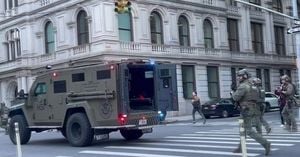On a chilly Thursday morning in October 2025, Nicholas Weininger stood in a line outside the San Francisco immigration court, waiting with dozens of others for the doors to open. The clock struck 8 a.m. when a security guard finally let them in, and Weininger made his way to the fourth floor at 630 Sansome Street—a building that houses both the Immigration and Customs Enforcement (ICE) field office and the immigration courtrooms. Clutching a form for notes, Weininger prepared to observe another round of asylum hearings, a weekly ritual he’s kept up for the past month and a half as a trained court watcher for the Bar Association of San Francisco.
Inside the courtroom of Judge Patrick O’Brien, tension was palpable. Two young Colombian women sat nervously, one in tears, while a Mexican mother and daughter whispered quietly. The docket was full: about 25 cases, all immigrants facing removal proceedings. Most were seeking asylum, fearing persecution if forced to return to their home countries. For many, hope hinged on the day’s proceedings.
Weininger, who balances his time between his engineering-management consulting business and composing music, has made court watching a personal mission. His grandfather, a Jewish refugee, fled rising antisemitism in the 1920s and found sanctuary in the United States—arriving just before the Immigration Act of 1924 imposed severe restrictions. "When I see people being mistreated, that’s the call to consciousness," Weininger explained, reflecting on his family’s history and his desire to support those now facing similar perilous crossroads.
He’s not alone in his efforts. Nearly 200 volunteers have been trained by the Bar Association to observe San Francisco’s immigration courts, documenting details like case numbers, addresses, and crucially, whether Department of Homeland Security (DHS) attorneys move to dismiss cases. According to Mission Local, since late May, 130 arrests have been tracked at the Sansome Street courthouse and its counterpart at 100 Montgomery Street. Court watchers like Weininger play a critical role, especially when pro-bono attorneys from the Bar Association’s Attorney of the Day program aren’t present. Their notes help track detainees, provide legal aid, and identify patterns in ICE’s enforcement tactics.
On that Thursday, DHS attorneys filed motions to dismiss three asylum cases. Judge O’Brien granted each motion—a decision that, more often than not, leads to immediate ICE arrests as soon as asylum seekers step outside the courtroom. Yet that morning, ICE agents were conspicuously absent. Still, the threat lingered, and the volunteers remained vigilant. Milli Atkinson, director of the Bar’s immigrant legal defense program, noted that when attorneys are present, they can quickly file habeas petitions to challenge detentions, boasting a 100% success rate at securing releases. Without legal representation, however, detainees are often left to face the system alone.
Weininger’s commitment is echoed by court watchers and legal advocates in other cities, where the stakes are just as high. In New York City, the daily scene at 26 Federal Plaza is fraught with anxiety. Undocumented immigrants line up every weekday to enter the federal building, passing a stern portrait of President Donald Trump before heading to the 12th and 14th floor immigration courtrooms. There, ICE agents—some in tactical vests and black balaclavas—wait in the hallways, ready to arrest individuals the moment their hearings conclude.
According to reporting by New York Magazine, ICE’s tactics in New York have shifted since late spring 2025. Rather than high-profile raids, agents now focus on detaining those who voluntarily appear at immigration courts. The agents, sometimes from other federal agencies like the FBI or Treasury Department, operate with a chilling efficiency. The rules for who is targeted remain opaque, and the process is often described as arbitrary and cruel.
Many of those detained are asylum seekers and other immigrants who have complied with court summonses and paperwork, seeking due process. Yet, as attorney Benjamin Remy of the New York Legal Assistance Group told New York Magazine, "What this administration has done is it has broadened the scope to encompass all of these categories so anyone here without lawful status can be detained without a hearing and without a bond." The American Civil Liberties Union and other civil rights groups are challenging these broad assertions of detention power in court, but for now, the arrests continue unabated.
The impact is deeply personal. On one October morning, a 34-year-old Ecuadorian mother attended her fourth hearing before Judge Kyle Dandelet. She and her family had fled gang violence, crossing the perilous Darién Gap and Mexico before settling in Newark. After her hearing, as she left the courtroom with her husband and young son, ICE agents moved in. The woman pleaded, "Help me," and, "They’re going to kill my son," as agents separated her from her family and took her into custody. An observer shouted, "Let her kiss her baby!"—but the agents ignored the pleas and led her away. Within days, she was transferred to the South Louisiana ICE Processing Center, a privately run facility where she would await possible deportation.
The scale of enforcement has grown dramatically. As of October 2025, more than 60,000 immigrants are in detention nationwide—a nearly 50% increase since the Trump administration took office. In New York alone, about half of the 2,300 detainees between January and June 2025 were arrested after routine court hearings or check-ins, according to federal data. Detainees are first held in cramped, often criticized holding cells on the 10th floor of Federal Plaza before being transferred to detention centers in Brooklyn, Newark, or even distant states like Florida, Louisiana, and Texas. A federal judge recently described the conditions in these holding areas as potentially "unconstitutional and inhumane." ICE, for its part, maintains that all operations comply with its National Detention Standards and that "all ICE arrests are made in compliance" with legal processes.
Despite the grim realities, volunteers, lawyers, and observers continue to show up. In both San Francisco and New York, they document proceedings, support families, and challenge detentions where possible. Weininger, for his part, finds solace in community: "At a time like this, when it feels like asylum seekers are under attack, I want to try and do what I can to continue to show up for them." He balances his advocacy with music—soon to debut a new composition in Seattle—but remains committed to the rhythm of court watching.
As the nation’s immigration system faces mounting pressure and controversy, the human stories unfolding in courthouse hallways—from California to New York—offer a sobering reminder of the stakes. For those who observe, support, and resist, the work continues, one hearing at a time.




